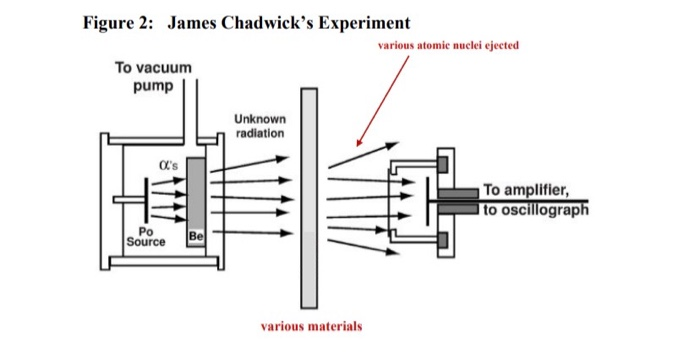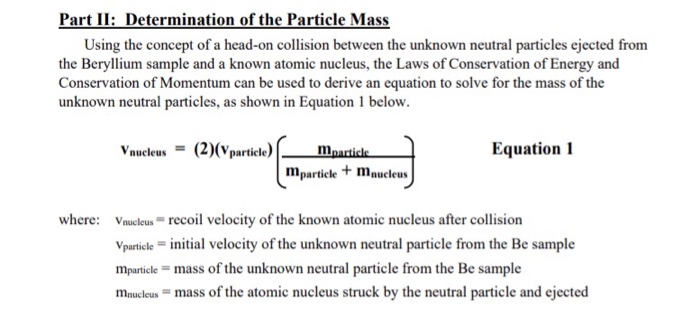Answered step by step
Verified Expert Solution
Question
1 Approved Answer
Figure 2: James Chadwick's Experiment To vacuum pump O's Po Source Bel Unknown radiation various materials various atomic nuclei ejected To amplifier, to oscillograph




Figure 2: James Chadwick's Experiment To vacuum pump O's Po Source Bel Unknown radiation various materials various atomic nuclei ejected To amplifier, to oscillograph Part II: Determination of the Particle Mass Using the concept of a head-on collision between the unknown neutral particles ejected from the Beryllium sample and a known atomic nucleus, the Laws of Conservation of Energy and Conservation of Momentum can be used to derive an equation to solve for the mass of the unknown neutral particles, as shown in Equation 1 below. Vnucleus (2)(Vparticle) mparticle mparticle + Mnucleus Equation 11 where: Vnucleus -recoil velocity of the known atomic nucleus after collision Vparticle initial velocity of the unknown neutral particle from the Be sample mparticle mass of the unknown neutral particle from the Be sample mnucleus = mass of the atomic nucleus struck by the neutral particle and ejected Problem #1: If the experiment from Figure #2 was run twice, using two different materials for the unknown neutral particles to collide into, derive the equation used by Chadwick that eliminated the neutral particle velocity and that he used to solve for the mass of the neutral particles. Take the ratio of Equation #1 for both species. Let the first nucleus have a recoil velocity of vi and a mass of mi. Let the second nucleus have a recoil velocity of v2 and a mass of m. Problem #2: Using the equation derived in Problem #1, solve for the mass of the neutral particles. Let hydrogen be the first nucleus, so that v = VH and m = m. Let nitrogen be the second nucleus, so that v2 = VN and m2 = ms. The recoil velocity of the hydrogen nucleus ejected was measured to be 3.3 x 107 m s and the recoil velocity for the nitrogen nucleus was measured to be 4.7 x 106 m s. Use atomic mass units (amu) for all particle and nucleus masses.
Step by Step Solution
★★★★★
3.36 Rating (152 Votes )
There are 3 Steps involved in it
Step: 1

Get Instant Access to Expert-Tailored Solutions
See step-by-step solutions with expert insights and AI powered tools for academic success
Step: 2

Step: 3

Ace Your Homework with AI
Get the answers you need in no time with our AI-driven, step-by-step assistance
Get Started


